|
Car 2514 |
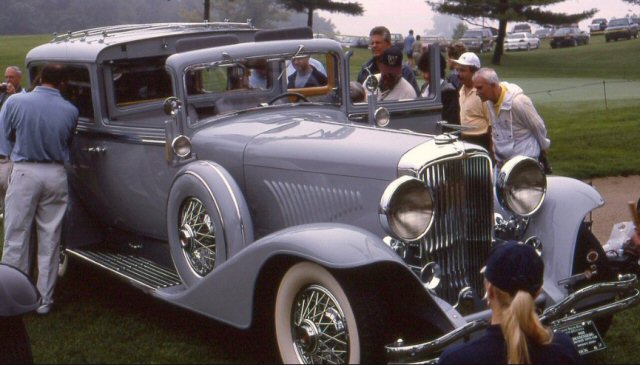 |
|
1933 Model J Duesenberg 2514,
Kirchhoff Town Car Limousine |
|
Engine No.:
|
J-497 [Picture] |
|
First Coachbuilder:
|
Kirchhoff |
|
First Body Style:
|
Town Car Limousine |
|
Wheelbase:
|
Long |
|
Current Coachbuilder:
|
|
|
Current Body Style:
|
|
|
Original Owner:
|
Anna Ingraham, Los
Angeles |
|
Owner in 1968:
|
Anthony Pascucci, 128
Paddock Ave, Meriden, CT |
|
Current Owner:
|
Dwyane ? |
|
References: |
Malks, p. 99, 100; Roe,
p. 138 |
Notes:
As the car appears today; standard bumpers have been re-installed.




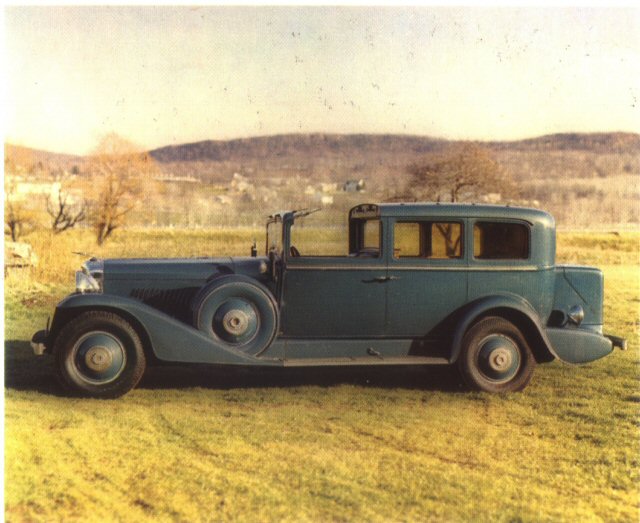
Shows the result of adding skirted
fenders and replacing the original bumpers with non-standard ones. From
Automobile Quarterly,
Vol. 4, No. 4, p. 361
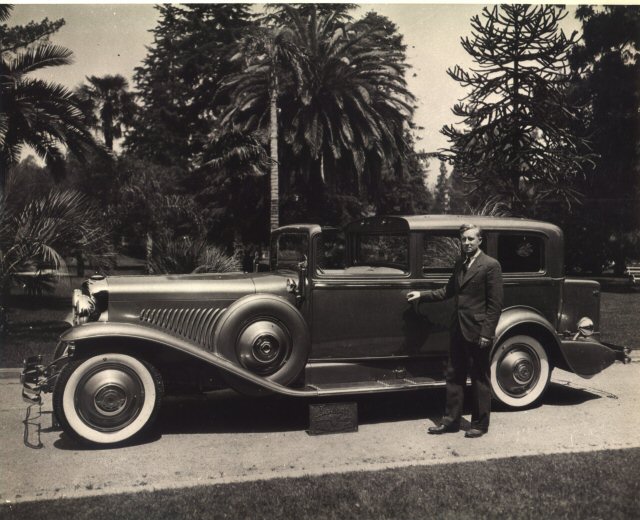
The coachbuilder, Joseph Kirchhoff, poses with the car,
1933. Photo from the Kirchhoff estate; also appears in "Duesenberg The Pursuit of
Perfection", p. 138.
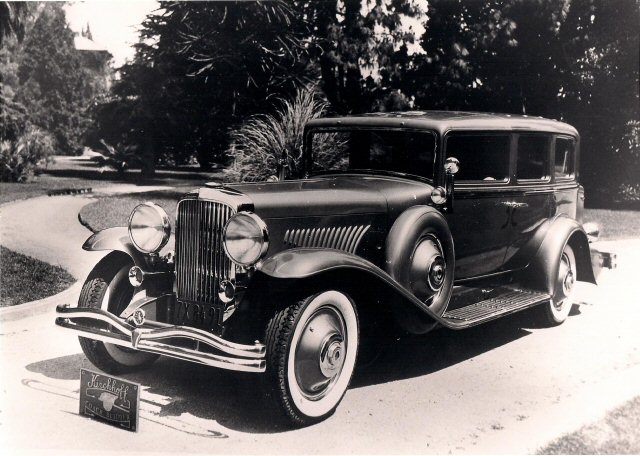
Photo from the Kirchhoff estate, 1933.
Provided by Joe Auch.
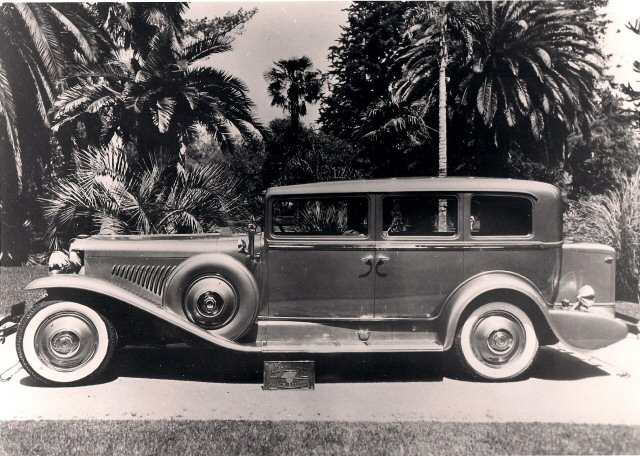
Photo from the Kirchhoff estate, 1933.
Provided by Joe Auch.
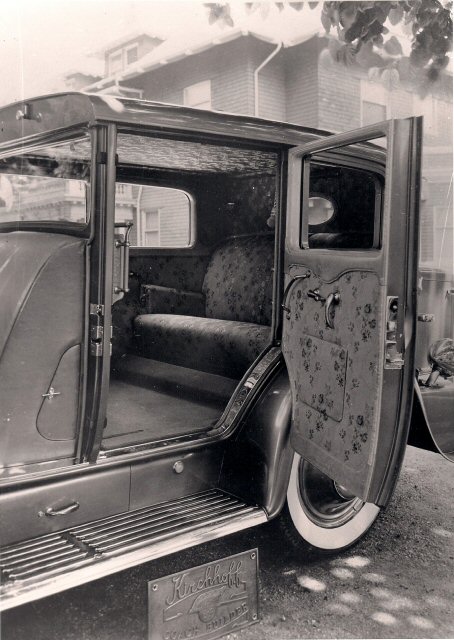
Photo from the Kirchhoff estate, 1933.
Provided by Joe Auch.

Photo from the Kirchhoff estate, 1933.
Provided by Joe Auch.
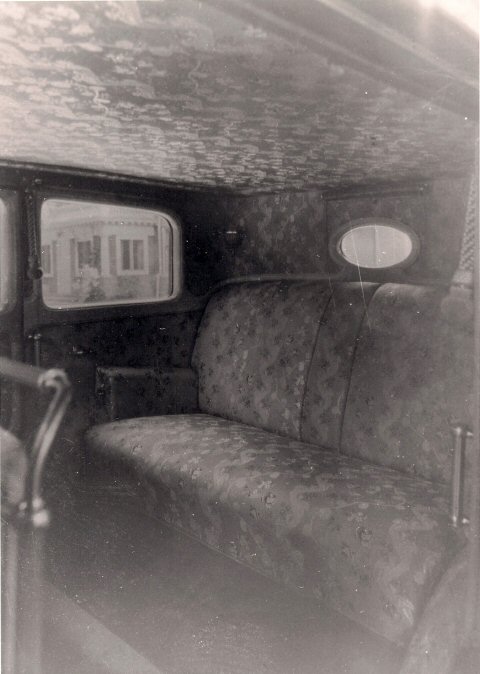
Photo from the Kirchhoff estate, 1933.
Provided by Joe Auch.
Lot Description (from 1999)
1932 DUESENBERG MODEL J TOWN CAR
COACHWORK BY KIRCHHOFF
Chassis No. 2514
Engine No. J-497
Two-tone dove grey with grey leather in the front compartment and custom silk
brocade in the rear compartment
Engine: straight-eight with twin overhead camshafts and four valves per
cylinder, 420ci., 320bhp at 4,200rpm; Gearbox: three speed manual; Suspension:
beam axle to front, live axle to rear, half-elliptic leaf springs all around;
Brakes: servo-assisted hydraulically operated drums on all wheels. Left hand
drive.
The late automotive writer, Ken Purdy, once wrote, The man who had really
arrived drove a Duesenberg. It cost him from 6,500 to 25,000
one-hundred-cent-dollars and it looked it. What is more, it acted like it.
Nobody driving a stock anything made in America passed a Duesenberg if the
Duesenberg was earnest about it. At the heart of that idea was the Model J
Duesenberg's massive powerhouse of an engine: complex sporting twin overhead
camshafts that controlled four inclined valves, two inlet and two exhaust, per
cylinder, displacing 420 cubic inches (6,882 cc). The great five bearing
crankshaft alone was reputed to weigh 150 lbs. Even with the modest 5.2:1
compression ratio of the standard engine, the surge of power was awesome,
thrusting a phaeton, very completely equipped and no lightweight, from 10-80 mph
in top gear in 22 seconds and providing a maximum of 116 mph. Matched to
the engine was a very capable chassis, double dropped for a low center of
gravity, provided with six sturdy cross-members.
Endless care was lavished on the details. The 150mph speedometer, the combined
clock and stop-watch altimeter, barometer and brake pressure dials were
highlighted by the famous engine-driven timing box of planetary gears that
controlled lights that warned the driver to change the engine oil every 700
miles and check the battery water every 1400 miles, along with other functions.
Duesenberg exercised firm control over the bodies fitted to their chassis',
encouraging clients to order coachwork directly from the factory, often with the
aid of Duesenberg executive and Cord stylist, Gordon Buehrig. Buehrig made sure
that only the best looking bodies went on the Duesenberg chassis'. As a result,
the choice of coachwork was limited to a select, elite group of companies that
included Murphy, Rollston, Gurney Nutting, Walker, Willoughby, LeBaron and
Hibbard and Darrin, and in the case of the chassis offered here, Kirchhoff.
In the early 1930s, Mrs. Anna C. Ingraham, placed an order at the Duesenberg
factory for a Long Wheel Base chassis which was to be fitted with a custom
one-off luxurious town car body built to her specifications. Mrs. Ingraham
resided in Austria, however the family business, The Ingraham Clock and Dollar
Watch Companies, was located in the United States. As an avid world traveler,
the Countess was accustomed to seeing the world in the most elegant and
comfortable of appointments. Accordingly, the Duesenberg was to be purpose built
to suit the Countess' high level of comfort expectations during long distance
touring whether in Continental Europe, the Americas or across an African Desert.
Following the completion of chassis 2514, the Duesenberg chassis and engine
(J497) were shipped to Kirchhoff Coachbuilders in Pasadena.
Prior to setting up on his own, J. Gerald Kirchhoff was the shop foreman at the
prestigious firm of Murphy. Kirchhoff's talents were in woodwork in particular
and he set out on his own to produce coachwork of the highest quality.
Unfortunately, during the Great Depression there was no demand for such work and
he produced only a few bodies: one for a Packard chassis, two for Miller
Speedsters and two for Duesenberg chassis'. Interestingly, the other Kirchhoff
bodied Duesenberg externally appeared almost identical to a Murphy Convertible
Sedan, however the structural design was radically different. It was much more
substantial and, quite unusually, all of the structural wood was stained, coated
and finished - demonstrating Kirchhoff's high standard for his work. 2514 was
his last project.
The ornate and stunning detail of this car is without parallel. The rear
compartment was upholstered with a specially chosen hand crafted silk brocade
floral pattern that was complemented by beautifully crafted bird's eye maple
cabinetry, complete with the Countess' initials A. I., hand carved for a
personalized touch. All of the interior brightwork, including the two floral
light sconces, was plated in 24 karat gold. Every last detail spoke of the
highest quality, from the beveled oval rear window to the gold plated floral
caps that hid the wood mounted screws, as there could not be anything that
displeased the Countess' eye. For convenience, an intercom system from the rear
quarters to the chauffeur's front compartment was installed, which naturally was
upholstered in a far less extravagant grey leather. The chauffeur did have the
option of fully enclosed motoring, or if weather permitted, the top could be
cranked back on a gear mechanism that cleanly recessed the front portion into
the rear top. In addition to the storage compartments and tool trays on both
sides of the front seat, hidden compartments in the floor in both the front and
rear were installed for the Countess' jewels and valuables. At the very rear
portion of the car near the base of the trunk were two water storage tanks,
accessible through keyed doors on either side. These well hidden tanks made for
the perfect accessories on any dangerous and long desert crossing!
Following its completion, the Kirchhoff Duesenberg was shipped to the Countess
in Europe and was used by her on many excursions, including a tour through
Africa, until just prior to the outbreak of World War II. Mr. Kirchhoff
recognized that the market for lavish coachbuilt bodies was rapidly dwindling
and therefore accepted the Countess' offer to be her personal and worldwide
chaffeur.
In the late 1930s the Duesenberg migrated back across the ocean and was housed
during the war in the Ingrahams' Connecticut estate. At some point, 2514 was
updated with the later style skirted fenders. Upon Anna Ingraham's death, it
passed into her nephew's ownership and he used it sparingly. Throughout the
1950s, the Duesenberg was displayed at the Powers Automobile Museum and was
eventually sold to them in the early 1960s. By 1965, collector Anthony Pascucci
acquired 2514 and it remained in his ownership until the early 1980s when the
present owner acquired the car.
When the current vendor purchased the Duesenberg, it was in complete original
condition, but in need of restoration. The Pennsylvania specialist firm of Al
Pruitt and Sons was commissioned to undertake the laborious and costly nut and
bolt restoration. Nearly all of the orginal silk brocade interior had, by this
time, faded dramatically. Fortunately, the armrests had been concealed from the
light and the brocade was carefully removed and custom duplicated to exactly
match the original - all at a tremendous cost. The only major item that had gone
missing in all of those years was the Jaeger chronograph. The restoration also
included a complete and thorough engine overhaul. Though all of the wood and
panels were wonderfully intact and certainly not in need of replacement, each
item was stripped and restored to its former glory for the sake of continuity.
The finished product is truly spectacular and, as our words serve only to
explain the story of this Duesenberg, we would recommend examining this
breathtaking sight with your own eyes. To add to the excitement and appeal of
this tremendous example, the Duesenberg has been shown competitively only once
since the restoration at an East Coast concours where it scored 100 points. It
will undoubtedly be a welcome entry at numerous concours throughout the world.
It is also a unique and highly correct matching numbers example. The Kirchhoff
Duesenberg is one of the most lavish and luxurious cars we have ever had the
pleasure of offering.











